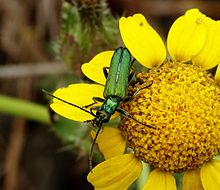Oedemeridae
| Oedemeridae Temporal range:
| |
|---|---|

| |
Anthemis tinctoria
| |
| Scientific classification | |
| Domain: | Eukaryota |
| Kingdom: | Animalia |
| Phylum: | Arthropoda |
| Class: | Insecta |
| Order: | Coleoptera |
| Suborder: | Polyphaga |
| Infraorder: | Cucujiformia |
| Superfamily: | Tenebrionoidea |
| Family: | Oedemeridae Latreille, 1810 |
| Subfamilies | |
The family Oedemeridae is a cosmopolitan group of beetles commonly known as false blister beetles, though some recent authors have coined the name pollen-feeding beetles. There are some 100 genera and 1,500 species in the family,[1] mostly associated with rotting wood as larvae, though adults are quite common on flowers. The family was erected by Pierre André Latreille in 1810.
Characteristics
Oedemeridae may be defined as slender, soft-bodied beetles of medium size found mostly on flowers and foliage. The head lacks a narrow neck, the
Natural history

The
Adults contain the
-feeding, and diurnal in activity. In tropical areas, most are nocturnal and are attracted to light.Evolutionary history
The oldest known member of the family is Darwinylus from the Albian aged Alava amber from the Escucha Formation, Spain, a basal member of the subfamily Oedemerinae.[2] Unlike living species of the family, the specimen was found with gymnosperm (suspected to be cycad) pollen on its body, suggesting that the family had a gymnosperm associated prior to switching to flowering plants.[3] Species of the extinct genus Ditysparedrus and extant genus Sparedrus belonging to the subfamily Calopodinae, are known from the Cenomanian aged Burmese amber of Myanmar.[4][5]

See also
References
- ISBN 84-931847-4-8
- S2CID 88791507.
- PMID 28262492.
- ^ F. Vitali and S. Ellenberger. 2019. Sparedrus archaicus n. sp., the first false blister beetle (Coleoptera, Oedemeridae) from Burmese amber. Baltic Journal of Coleopterology 19:23-27
- ISSN 2707-9783.
External links
- false blister beetles on the UF / IFAS Featured Creatures Web site
